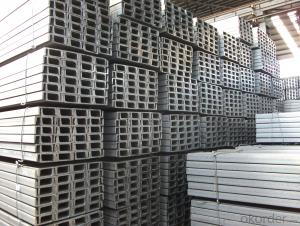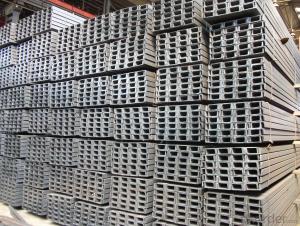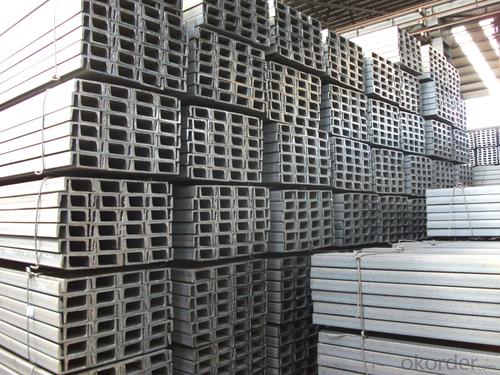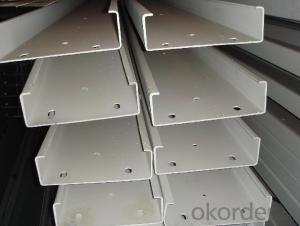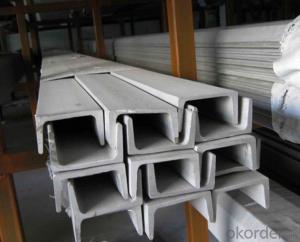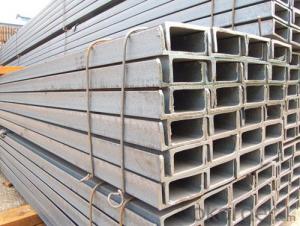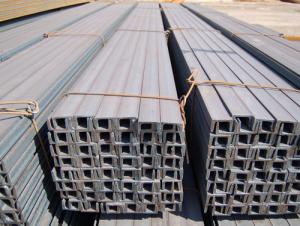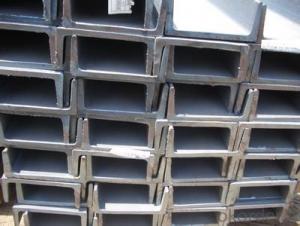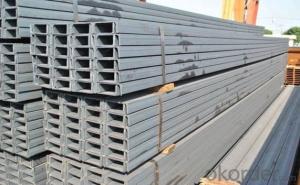U CHANNEL
- Loading Port:
- China Main Port
- Payment Terms:
- TT OR LC
- Min Order Qty:
- -
- Supply Capability:
- -
OKorder Service Pledge
OKorder Financial Service
You Might Also Like
Specifications of MS Channel:
1.We supply high quality MS Channel at reasonable price, including Chinese standard, Japanese standard and so on.
Standard | GB/JIS |
Material Grade | Q235,SS400 |
Technique: | Hot Rolled |
Sizes as per chinese standard: | 50*37*4.5mm - 300*89*11.5mm |
Sizes as per japanese standard: | 50*25*3mm – 200*80*7.5mm |
Length: | 6meter, 9meter, 12meter |
Note: 1.we are also competent to provide our customers other MS Channel based on other sizes according to customer’s requirements.
2. The length of our ms channel could be cut into other meters as per customer’s requirements. For example, the channel in 6meters could be cut into 5.8meters in order to be fit in the 20ft container.
2. The detailed sections of MS Channel as per GB standard.are shown in the table-1:
GB U CHANNEL | Standard | Sectional | Dimension |
| Mass: |
| (mm) | (mm) | (mm) | (mm) |
|
50X37 | 50 | 37 | 4.50 | 7.0 | 5.438 |
63X40 | 63 | 40 | 4.80 | 7.5 | 6.634 |
80x43 | 80 | 43 | 5.00 | 8.0 | 8.045 |
|
|
|
|
|
|
100x48 | 100 | 48 | 5.30 | 8.5 | 10.007 |
120x53 | 120 | 53 | 5.50 | 9.0 | 12.059 |
140x58 | 140 | 58 | 6.00 | 9.5 | 14.535 |
140x60 | 140 | 60 | 8.00 | 9.5 | 16.733 |
|
|
|
|
|
|
160x63 | 160 | 63 | 6.50 | 10.0 | 17.240 |
160x65 | 160 | 65 | 8.50 | 10.0 | 19.752 |
|
|
|
|
|
|
180x68 | 180 | 68 | 7.00 | 10.5 | 20.174 |
180x70 | 180 | 70 | 9.00 | 10.5 | 23.000 |
|
|
|
|
|
|
200x73 | 200 | 73 | 7.00 | 11.0 | 22.637 |
200x75 | 200 | 75 | 9.00 | 11.0 | 25.777 |
|
|
|
|
|
|
220x77 | 220 | 77 | 7.00 | 11.5 | 24.999 |
220x79 | 220 | 79 | 9.00 | 11.5 | 28.453 |
|
|
|
|
|
|
250x78 | 250 | 78 | 7.00 | 12.0 | 27.410 |
250x80 | 250 | 80 | 9.00 | 12.0 | 31.335 |
250x82 | 250 | 82 | 11.00 | 12.0 | 35.260 |
|
| |
|
|
|
280x82 | 280 | 82 | 7.50 | 12.5 | 31.427 |
280x84 | 280 | 84 | 9.50 | 12.5 | 35.823 |
280x86 | 280 | 86 | 11.50 | 12.5 | 40.219 |
|
|
|
|
|
|
300x85 | 300 | 85 | 7.50 | 13.5 | 34.463 |
300x87 | 300 | 87 | 9.50 | 13.5 | 39.173 |
300x89 | 300 | 89 | 11.50 | 13.5 | 43.883 |
Table-1
3. The chemical composition of HR Channel Steel according to Q235B is shown in Table-2.
Alloy No | Grade | Element(%) | ||||
C | Mn | S | P | Si | ||
Q235 | B | 0.12-0.20 | 0.3-0.7 | ≦0.045 | ≦0.045 | ≦0.3 |
Table-2
Note: we are able to present our customers relevant SGS test report for chemical composition of HR Channel Steel.
4. The mechanical property of HR Channel Steel according to Q235B is shown in Table-3-1 and Table-3-2
Alloy No | Grade | Yielding Strength Point(Mpa) | |||
Thickness(mm) | |||||
≦16 | >16-40 | >40-60 | >60-100 | ||
≧ | |||||
Q235 | B | 235 | 225 | 215 | 205 |
Table-3-1
Alloy No | Grade | Tensile Strength(Mpa) | Elongation After Fracture(%) | |||
| | Thickness(mm) | |||||
≦16 | >16-40 | >40-60 | >60-100 | |||
≧ | ||||||
G235 | B | 375-500 | 26 | 25 | 24 | 23 |
Table-3-2
Note: we are able to present our customers relevant SGS test report for mechanical property of MS Channel as customer’s request.
Applications of MS Channel:
The MS Channel can be applied to construction of warehouses, workshops, sport stadiums and car parks etc.The hot rolled channel steel belongs to carbon structural steel which is applied to in the field of construction and machinery.In details, the hot rolled channel steel is usually used for arch-itechtural structure, and they could be welded in order to support or hang a vari-ety of facilities. They are also usually used in combination with I beam. Generally,the hot rolled channel steel we supply must possess perfect welding property, riveting property and mechanical property and so on.
Package & Delivery of MS Channel:
1.The hot rolled channel steel will be packed in bundle with steel wire at each end of every bundle and color marking in order to help the customer to recognize his goods more easily at sight.
2. And the hot rolled channel steel could be loaded into 20ft or 40ft container, or by bulk cargo.If the weight of each bundle reaches more than 3.5 mt, the loading by break bulk cargo should be choosed.When the weight of each bundle reaches less than 3mt, the loading by container should be choosed.
3.As for the transportaion from mill to loading port, the truck will be usually used. And the maximum quantity for each truck is 40mt.
4.All in all, we could do in accordance with customer's request.
- Q: Can steel channels be used in electrical applications?
- Yes, steel channels can be used in electrical applications. Steel channels are often used in electrical installations to provide support and protection for electrical cables and wiring. They are commonly used in industrial and commercial settings where durability and strength are important. Steel channels are typically made from galvanized steel, which provides corrosion resistance and ensures a long lifespan. They can be easily installed and provide a stable and secure pathway for electrical cables, helping to prevent damage and maintain a neat and organized wiring system. Additionally, steel channels can be used to mount electrical equipment and components, such as junction boxes or conduits, allowing for easy access and maintenance. Overall, steel channels are a reliable and versatile option for electrical applications.
- Q: Are steel channels suitable for use in the construction of utility poles?
- No, steel channels are not suitable for use in the construction of utility poles. Utility poles typically require materials that have specific properties such as high strength, resistance to weather and corrosion, and ability to withstand various loads. Steel channels may not possess all of these characteristics, hence other materials like wood, concrete, or composite materials are commonly used for utility poles.
- Q: How do steel channels contribute to sustainable construction?
- Steel channels contribute to sustainable construction in several ways. Firstly, steel is a highly durable material that can withstand extreme weather conditions and has a long lifespan, reducing the need for frequent replacements. Additionally, steel channels are often made from recycled materials, reducing the demand for raw resources and minimizing waste. Steel is also highly recyclable, making it a sustainable choice as it can be repurposed at the end of its lifespan. Furthermore, steel channels are lightweight, which reduces the energy required for transportation and installation. Overall, steel channels offer strength, durability, recyclability, and reduced environmental impact, making them a sustainable choice for construction projects.
- Q: I think the channel model specifies the standard of cross section, and -39 refers to the length of the channel. Thank you for your answer.
- 10# channel steel, size is 100 wide, leg height 48, thickness 5.339 may be the number! This should be based on specific drawings
- Q: Can steel channels be used for window frames?
- Window frames can indeed utilize steel channels. These channels possess great strength and durability, making them an ideal choice for supporting window glass and providing structural integrity to the frame. Custom window frames of various sizes and shapes can be easily created by fabricating and welding steel channels. Furthermore, the high resistance to corrosion exhibited by steel channels ensures that the window frames will last a long time and require minimal maintenance. However, it is important to consider the thermal conductivity of steel, as it can result in heat loss or gain through the frame. To address this concern, thermal breaks or insulation can be incorporated into the window frame design. All in all, steel channels offer a dependable and adaptable option for both residential and commercial window frames.
- Q: How do you calculate the weight of 100 channel steel?
- CAD drawing can also be used to calculate the cross-sectional area of 100 channel, or other ways to first calculate the cross section area of 100 channel.
- Q: Can steel channels be used in architectural facades?
- Yes, steel channels can be used in architectural facades. Steel channels offer structural stability, durability, and versatility, making them suitable for various architectural applications, including facades. They can be used to create visually appealing designs, provide support for cladding materials, and serve as a framework for architectural features such as windows or louvers.
- Q: How do steel channels compare to other structural shapes?
- Steel channels are a versatile and cost-effective choice for structural applications. They offer excellent strength-to-weight ratio, making them suitable for various load-bearing purposes. Compared to other structural shapes like I-beams or angles, steel channels provide better torsional resistance and are often easier to fabricate and install. Additionally, their flat and uniform shape allows for efficient connections and integration with other components, making them a preferred choice for many construction projects.
- Q: Can steel channels be used in rooftop installations?
- Yes, steel channels can be used in rooftop installations. Steel channels are commonly used for structural support in various construction applications, including rooftop installations. They provide strength and stability to the structure, making them suitable for holding heavy loads and withstanding external forces. Additionally, steel channels are durable and resistant to corrosion, making them a reliable choice for rooftop installations that are exposed to weather conditions.
- Q: Can steel channels be used for storage racks?
- Yes, steel channels can be used for storage racks. Steel channels provide strength and durability, making them suitable for holding heavy loads in storage applications. They can be easily customized and adjusted to accommodate different storage needs.
Send your message to us
U CHANNEL
- Loading Port:
- China Main Port
- Payment Terms:
- TT OR LC
- Min Order Qty:
- -
- Supply Capability:
- -
OKorder Service Pledge
OKorder Financial Service
Similar products
Hot products
Hot Searches
Related keywords
